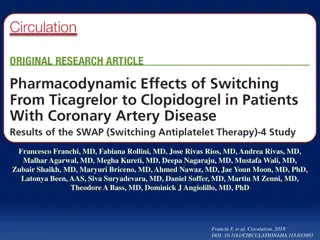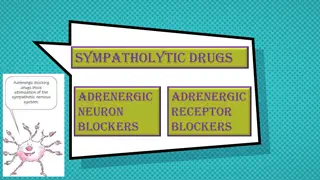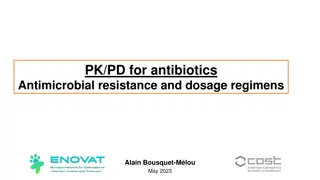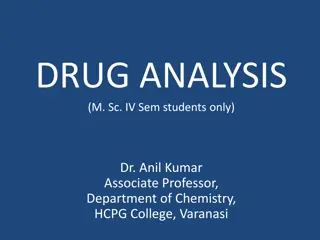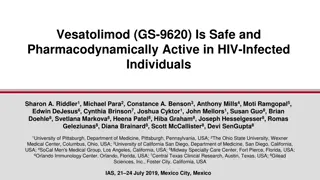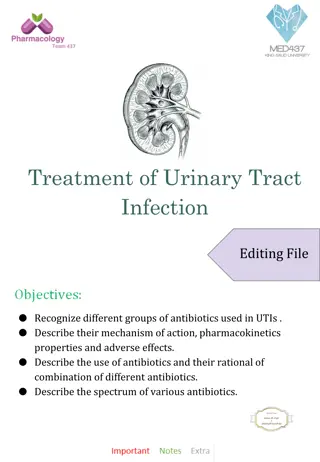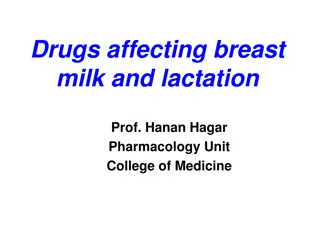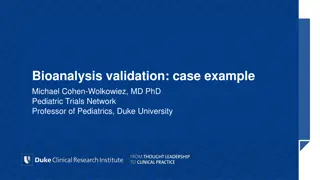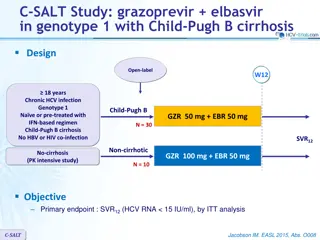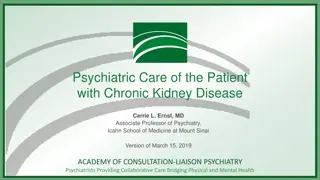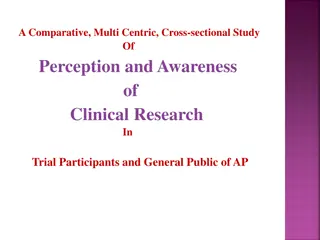Understanding Clinical Pharmacokinetic and Pharmacodynamic Concepts
Clinical pharmacokinetics involves applying pharmacokinetic principles to personalize medication dosages for optimal therapeutic effects while minimizing adverse reactions. It covers drug absorption, distribution, metabolism, and excretion. Pharmacodynamics focuses on the relationship between drug concentration and its pharmacological response, highlighting that the effect may not directly correlate with the dose or concentration increase. Linear and nonlinear pharmacokinetics determine how drug concentrations reach a balance during constant administration.
Download Presentation

Please find below an Image/Link to download the presentation.
The content on the website is provided AS IS for your information and personal use only. It may not be sold, licensed, or shared on other websites without obtaining consent from the author. Download presentation by click this link. If you encounter any issues during the download, it is possible that the publisher has removed the file from their server.
E N D
Presentation Transcript
Clinical Pharmacokinetic and Pharmacodynamic Concepts Dr. Haider Raheem Mohammad
Introduction Clinical pharmacokinetics is the discipline that applies pharmacokinetic concepts and principles in humans in order to design individualized dosage regimens which optimize the therapeutic response of a medication while minimizing the chance of an adverse drug reaction. Pharmacokinetics is the study of the absorption, distribution, metabolism, and excretion of drugs.
Introduction Absorption: Passage of drug molecules through physiological/biological barriers before reaching the vascular system. Distribution: Passage of drug molecules from the bloodstream into tissues and organs. Metabolism: Chemical conversion of a drug molecule into a metabolite. Excretion: The irreversible loss of a drug in a chemically unchanged or unaltered form and commonly occurs via the kidney or biliary tract. Elimination: The irreversible loss of drug from the site of measurement (blood, serum, plasma). Elimination of drugs occur by one or both of: (1) metabolism; (2) excretion.
Introduction Pharmacodynamics is the relationship between drug concentration and pharmacological response. It is extremely important for clinicians to realize that the change in drug effect is usually not proportional to the change in drug dose or concentration. For example, when a drug dose or concentration is increased from a baseline value, the increase in pharmacological effect is greater when the initial dose or concentration is low compared to the change in drug effect observed when the initial dose or concentration is high.
Introduction The relationship between drug concentration and response is usually a hyperbolic function: Effect = (Emax C)/(EC50+ C), where Emaxis the maximum effect and EC50is the drug concentration where the drug effect equals Emax/2.
Linear Vs. Nonlinear Pharmacokinetics When drugs are given on a constant basis, such as a continuous intravenous infusion or an oral medication given every 12 hours, serum drug concentrations increase until the rate of drug administration equals the rate of drug metabolism and excretion. At that point, serum drug concentrations become constant. For example, if theophylline is given as a continuous infusion at a rate of 50 mg/h, theophylline serum concentrations will increase until the removal of theophylline via hepatic metabolism and renal excretion equals 50 mg/h.
Linear Vs. Nonlinear Pharmacokinetics When medications are given on a continuous basis, serum concentrations increase until the rate of drug administration equals the elimination rate. In this case, the solid line shows serum concentrations in a patient receiving intravenous theophylline at a rate of 50 mg/h (solid line) and oral theophylline 300 mg every 6 hours (dashed line). Since the oral dosing rate (dose/dosage interval = 300 mg/6 h = 50 mg/h) equals the intravenous infusion rate, the drug accumulation patterns are similar.
Linear Vs. Nonlinear Pharmacokinetics If a plot of steady-state concentration versus dose yields a straight line, the drug is said to follow linear pharmacokinetics. In this situation, steady-state serum concentrations proportionally with dose. Therefore, if a patient has a steady-state drug concentration of 10 g/mL at a dosage rate of 100 mg/h, the steady-state serum concentration will increase to 15 g/mL if the dosage rate is increased to 150 mg/h (e.g., a 50% increase in dose yields a 50% increase in steady- state concentration). increase or decrease
Linear Vs. Nonlinear Pharmacokinetics When doses are increased for most drugs, steady-state increase in a proportional fashion leading to linear pharmacokinetics (solid line). However, in some cases proportional increases in steady-state concentrations do not occur after a dosage increase. When steady-state concentrations increase more than expected after a dosage increase (upper dashed line), Michaelis-Menten may be taking place. If steady-state increase less than expected after a dosage increase (lower dashed line), saturable plasma protein binding or autoinduction are likely explanations. concentrations pharmacokinetics concentrations
Linear Vs. Nonlinear Pharmacokinetics When steady-state concentrations change in a disproportionate fashion after the dose is altered, a plot of steady-state concentration versus dose is not a straight line and the drug is said to follow nonlinear pharmacokinetics. When steady-state concentrations increase more than expected after a dosage increase, the most likely explanation is that the processes removing the drug from the body have become saturated. This phenomenon is known as saturable or Michaelis-Menten pharmacokinetics. Both phenytoin and salicylic acid follow Michaelis- Menten pharmacokinetics.
Linear Vs. Nonlinear Pharmacokinetics When steady-state concentrations increase less than expected after a dosage increase, there are two typical explanations. Some drugs, such as valproic acid and disopyramide, saturate plasma protein binding sites so that as the dosage is increased steady-state serum concentrations increase less than expected. Other drugs, such as carbamazepine, increase their own rate of metabolism from the body as dose is increased so steady-state serum concentrations increase less than anticipated. This process is known as autoinduction of drug metabolism.
Clearance The definition of clearance is the volume of serum or blood completely cleared of the drug per unit time. Thus, the dimension of clearance is volume per unit time, such as L/h or mL/min. The liver is most often the organ responsible for drug metabolism while in most cases the kidney is responsible for drug elimination. The gastrointestinal wall, lung, and kidney can also metabolize some drugs, and some medications are eliminated unchanged in the bile.
Clearance Drug metabolism is characterized as Phase I reactions, which oxidize drug molecules, and Phase II reactions, which form glucuronide or sulfate esters with drug molecules. In either case, the resulting metabolite is more water soluble than the parent drug, and is more likely to be eliminated in the urine. The majority of drug metabolism is catalyzed by enzymes contained in the microsomes of hepatocytes known as the cytochrome P-450 (CYP) enzyme system.
Clearance Clearance (Cl) is the most important pharmacokinetic parameter because it determines the maintenance dose (MD) that is required to obtain a given steady-state serum concentration (Css): MD = Css Cl Target steady-state concentrations are usually chosen from previous studies in patients that have concentrations and maximum concentrations that produce the desired pharmacological effect but avoid toxic side effects. This range of steady-state concentrations is known as the therapeutic range for the drug. determined minimum effective
Clearance For example, the therapeutic range for theophylline is generally accepted as 10 20 g/mL for the treatment of asthma with concentrations of 8 12 g/mL considered as a reasonable starting point. If it were known that the theophylline clearance for a patient equaled 3 L/h and the desired steady-state theophylline serum concentration was 10 g/mL, the theophylline maintenance dose to achieve this concentration would be 30 mg/h. 10 g/mL = 10 mg/L; MD = Css Cl MD = 10 mg/L 3 L/h = 30 mg/h.
Clearance The clearance for an organ, such as the liver or kidney, that metabolizes or eliminates drugs is determined by the blood flow to the organ and the ability of the organ to metabolize or eliminate the drug. Liver blood flow (LBF) and renal blood flow (RBF) are each ~ 1 1.5 L/min in adults with normal cardiovascular function. The ability of an organ to remove or extract the drug from the blood or serum is usually measured by determining the extraction ratio (ER), which is the fraction of drug removed by the organ, and is computed by measuring the concentrations of the drug entering (Cin) and leaving (Cout) the organ: ER = (Cin Cout)/ Cin
Clearance This schematic depicts the liver (large box) with the blood vessel supplying blood to it. When drug molecules (D) enter an organ (blood flows from left to right) that clears the drug, they may be bound to plasma proteins (trapezoid shapes) or exist in the unbound state.
Clearance Liver or renal blood flow and the extraction ratio for a drug are rarely measured in patients. The drug clearance for an organ is equal to the product of the blood flow to the organ and the extraction ratio of the drug. Therefore, hepatic clearance (ClH) for a drug would be determined by taking the product of liver blood flow and the hepatic extraction ratio (ERH) for the drug (ClH= LBF ERH); And renal clearance (ClR) for a medication would be determined by multiplying renal blood flow and the renal extraction ratio for the agent (ClR= RBF ERR).
Clearance For example, verapamil has a hepatic extraction ratio of 90% (ERH= 0.90). For patients with normal liver blood flow (LBF = 1.5 L/min), hepatic clearance would be expected to equal 1.35 L/min ClH= LBF ERH ClH= 1.5 L/min 0.90 = 1.35 L/min. The total clearance for a drug is the sum of the individual clearances for each organ that extracts the medication. For example, the total clearance (Cl) for a drug that is metabolized by the liver and eliminated by the kidney is the sum of hepatic and renal clearance for the agent: Cl = ClH+ ClR
Hepatic Clearance Hepatic clearance value is a function of three physiological factors: 1. The intrinsic clearance (Cl int) is the inherent ability of the enzyme to metabolize the drug and is the quotient of the Michaelis-Menten constants Vmaxand Km (Cl int= Vmax/Km) for the unbound drug. 2. The fraction of drug present in the bloodstream that is not bound to cells or proteins, such as albumin, 1-acid glycoprotein, or lipoproteins, but is present in the unbound, or free, state (unbound fraction of drug); The unbound fraction of drug in the blood or serum (fB) is the unbound drug concentration divided by the total (bound + unbound) drug concentration. 3. Liver blood flow.
Hepatic Clearance The relationship between the three physiological factors and hepatic drug clearance is: ??? .(fB.Cl int) ??? + (fB.Cl int) ClH= Fortunately, most drugs have a large hepatic extraction ratio (ERH 0.7) or a small hepatic extraction ratio (ERH 0.3), and the relationship is simplified in these situations.
Hepatic Clearance For drugs with a low hepatic extraction ratio, hepatic clearance is mainly a product of the free fraction of the drug in the blood or serum and intrinsic clearance: ClH= fB Cl int. The hepatic clearance of drugs with low extraction ratios does not change much when liver blood flow decreases secondary to liver or cardiac disease. Examples of drugs with low hepatic extraction ratios are valproic acid, phenytoin, and warfarin.
Hepatic Clearance For drugs with high hepatic extraction ratios, hepatic clearance is mainly a function of liver blood flow: ClH= LBF. The rate limiting step for drug metabolism in this case is how much drug can be delivered to the liver because the capacity to metabolize drug is very large. The hepatic clearance of drugs with high extraction ratios does not change much when protein binding displacement or enzyme induction or inhibition occurs due to drug interactions. Examples of drugs with high hepatic extraction ratios are lidocaine, morphine, and most tricyclic antidepressants.
Renal Clearance The physiological determinants of renal clearance are glomerular filtration rate (GFR), the free fraction of drug in the blood or serum (fB), the clearance of drug via renal tubular secretion (Clsec), and the fraction of drug reabsorbed in the kidney (FR): ClR= [(fB GFR) + Clsec] (1 FR) Average glomerular filtration rates in adults with normal renal function are 100 120 mL/min. Since tubular secretion is an active process, it has been described by an equation similar to that used to explain liver metabolism: Clsec= [RBF (fBCl sec)] / [RBF + (fBCl sec)] where Cl secis the intrinsic clearance due to active tubular secretion.
Renal Clearance Thus, the entire equation is: ??? .(fB.Cl sec) ??? + (fB.Cl sec)](? ??) ClR= [ fB.??? + If the renal clearance of a drug is greater than glomerular filtration rate, it is likely that the drug was eliminated, in part, by active tubular secretion. The aminoglycoside antibiotics and vancomycin are eliminated primarily by glomerular filtration. Digoxin, procainamide, ranitidine, and ciprofloxacin are eliminated by both glomerular filtration and active tubular secretion.
Volume of Distribution Volume of distribution (V) is an important pharmacokinetic parameter because it determines the loading dose (LD) that is required to achieve a particular steady-state drug concentration immediately after the dose is administered: LD = Css V
Volume of Distribution The volume of distribution (V) is a hypothetical volume that is the proportionality constant which relates the concentration of drug in the blood or serum (C) and the amount of drug in the body (AB): AB= C V. If the minimum concentration needed to exert the pharmacological effect of the drug is 5 mg/L, one patient will receive a benefit from the drug while the other will have a subtherapeutic concentration.
Volume of Distribution It is rare to know the exact volume of distribution for a patient because it is necessary to administer a dose on a previous occasion in order to have computed the volume of distribution. Thus, usually an average volume of distribution measured in other patients with similar demographics (age, weight, gender, etc.) and medical conditions (renal failure, liver failure, heart failure, etc.) is used to estimate a loading dose. Because of this, most patients will not actually attain steady state after a loading dose, but, hopefully, serum drug concentrations will be high enough so that the patient will experience the pharmacological effect of the drug.
Volume of Distribution This example depicts the ideal loading dose given as an intravenous bolus dose followed by a continuous intravenous infusion (solid line starting at 16 mg/L) so steady state is achieved immediately and maintained. If a loading dose was not given and a continuous infusion started (dashed line starting at 0 mg/L). the patient s volume of distribution may be smaller than average and result in higher than expected concentrations (solid line starting at 30 mg/L) or larger than average and result in lower than expected concentrations (dotted line starting at 7 mg/L). In these cases, it still takes 3 5 half-lives to reach steady-state, but therapeutic drug concentrations are achieved much sooner than giving the drug by intravenous infusion only.
Volume of Distribution The volume of distribution can be very small if the drug is primarily contained in the blood (warfarin V = 5 7 L), or very large if the drug distributes widely in the body and is mostly bound to bodily tissues (digoxin V = 500 L). The physiologic determinates of volume of distribution are the actual volume of blood (VB) and size (measured as a volume) of the various tissues and organs of the body (VT). Therefore, a larger person, such as a 160-kg football player, would be expected to have a larger volume of distribution for a drug than a smaller person, such as a 40-kg grandmother.
Volume of Distribution The reason warfarin has such a small volume of distribution is that it is highly bound to serum albumin so that the free fraction of drug in the blood (fB) is very small. Digoxin has a very large volume of distribution because it is very highly bound to tissues (primarily muscle) so that the free fraction of drug in the tissues (fT; fT= unbound drug concentration in the tissue/total tissue drug concentration) is very small. The equation that relates all of these physiologic determinates to the volume of distribution is: V = ??+fB ?? fT
Volume of Distribution An example is how the volume of distribution changes when plasma protein binding drug interactions occur. If a drug that is highly bound to plasma proteins is given to a patient, and then a second drug that is also highly bound to the same plasma protein is given concurrently, the second drug will compete for plasma protein binding sites and displace the first drug from the protein. In this case, the free fraction in the serum of the first drug will increase ( fB), resulting in an increased volume of distribution: V = ??+ fB ?? fT
Half-Life and Elimination Rate Constant When drugs that follow linear pharmacokinetics are given to humans, serum concentrations decline in a curvilinear fashion. Serum concentration/time profile for a patient receiving 300 mg of theophylline orally (solid line) and by intravenous bolus (dashed line). If this data is plotted on rectilinear axes, serum concentrations decline in a curvilinear fashion in both cases.
Half-Life and Elimination Rate Constant When the same data is plotted on a semilogarithmic axis, serum concentrations decrease in a linear fashion after drug absorption and distribution phases are complete. Serum concentration/time profile for a patient receiving 300 mg of theophylline orally (solid line) and by intravenous bolus (dashed line). If this data is plotted on semilogarithmic axes, serum concentrations decline in a straight line in both cases.
Half-Life This part of the curve is known as the elimination phase. The time that it takes for serum concentrations to decrease by 1/2 in the elimination phase is a constant and is called the half-life (t1/2). The half-life describes how quickly drug serum concentrations decrease in a patient after a medication is administered, and the dimension of half-life is time (minute, hour, day, etc.). Half-life: Time required for serum concentrations to decrease by one- half after absorption and distribution phases are complete.
Elimination Rate Constant Another common measurement used to denote how quickly drug serum concentrations decline in a patient is the elimination rate constant (ke). The dimension for the elimination rate constant is reciprocal time (minute 1, hour 1, day 1, etc.). Elimination rate constant: Terminal slope (using an ln C versus time plot) of the serum concentration/time curve after absorption and distribution phases are complete.
Half-Life and Elimination Rate Constant If the amount of drug in the body is known, the elimination rate for the drug can be computed by taking the product of the elimination rate constant and the amount of drug in the body (AB): elimination rate = AB ke The half-life and elimination rate constant are related to each other by the following equation, so it is easy to compute one once the other is known: t1/2= 0.693/ke
Half-Life and Elimination Rate Constant The elimination rate constant can also be measured graphically by computing the slope of the log concentration versus time graph during the elimination phase: using log10, ke/2.303 = (log C1 log C2) / (t1 t2) or, using natural logarithms, ke= (ln C1 ln C2) / (t1 t2)
Half-Life If a drug is administered on a continuous basis for 3 half-lives, serum concentrations are ~90% of steady-state values; on a continuous basis for 5 half-lives, serum concentrations equal ~95% of steady-state values; or on a continuous basis for 7 half-lives, serum concentrations achieve ~99% of steady-state values. Generally, drug serum concentrations used for pharmacokinetic monitoring can be safely measured after 3 5 estimated half-lives because most drug assays have 5 10% measurement error.
Half-Life Serum concentration/time graph for a drug that has a half-life equal to 8 hours. The arrows indicate concentrations at 3 half-lives (24 hours, ~90% of Css) and at 5 half-lives (40 hours, ~95% of Css). Since most drug assays have 5 10% measurement error, serum concentrations obtained between 3 5 half- lives after dosing commenced can be considered to be at steady state for clinical purposes and used to adjust drug doses.
Half-Life and Elimination Rate Constant The dosage interval for a drug is also determined by the half-life of the medication. For example, if the therapeutic range of a drug is 10 20 mg/L, the ideal dosage interval would not let maximum serum concentrations exceed 20 mg/L or allow the minimum serum concentration to go below 10 mg/L The dosage interval for a drug is determined by the half-life of the agent. In this case, the half-life of the drug is 8 hours, and the therapeutic range of the drug is 10 20 mg/L.
Half-Life and Elimination Rate Constant The half-life and elimination rate constant are known as dependent parameters because their values depend on the clearance (Cl) and volume of distribution (V) of the agent: t1/2= (0.693 V)/Cl ke= Cl/V The half-life and elimination rate constant for a drug can change either because of a change in clearance or a change in the volume of distribution. Because the values for clearance and volume of distribution depend solely on physiological parameters and can vary independently of each other, they are known as independent parameters.
Michaelis-Menten or Saturable Pharmacokinetics This is the type of nonlinear pharmacokinetics that occurs when the number of drug molecules overwhelms or saturates the enzyme s ability to metabolize the drug. When this occurs, steady-state drug serum concentrations increase in a disproportionate manner after a dosage increase. Maud Leonora Menten (March 20, 1879 July 17, 1960) was a Canadian physician and chemist. Leonor Michaelis (16 January 1875 8 October 1949) was a German biochemist, physical chemist, and physician.
Michaelis-Menten or Saturable Pharmacokinetics In this case the rate of drug removal is described by the classic Michaelis-Menten relationship that is used for all enzyme systems: rate of metabolism =Vmax C Km + C where Vmax is the maximum rate of metabolism, C is the substrate concentration, and Km is the substrate concentration where the rate of metabolism = Vmax /2.
Michaelis-Menten or Saturable Pharmacokinetics The clinical implication of Michaelis-Menten pharmacokinetics is that the clearance of a drug is not a constant as it is with linear pharmacokinetics, but is concentration- or dose-dependent. As the dose or concentration increases, the clearance rate (Cl) decreases as the enzyme approaches saturable conditions: Cl = Vmax/(Km + C) This is the reason concentrations increase disproportionately after a dosage increase.
Michaelis-Menten or Saturable Pharmacokinetics For example, phenytoin follows saturable pharmacokinetics with average Michaelis-Menten constants of Vmax = 500 mg/d and Km = 4 mg/L. The therapeutic range of phenytoin is 10 20 mg/L. As the steady-state concentration of phenytoin increases from 10 mg/L to 20 mg/L, clearance decreases from 36 L/d to 21 L/d. Cl = Vmax /(Km + C) Cl = (500 mg/d) / (4 mg/L + 10 mg/L) = 36 L/d Cl = (500 mg/d) / (4 mg/L + 20 mg/L) = 21 L/d
Michaelis-Menten or Saturable Pharmacokinetics The volume of distribution (V) is unaffected by saturable metabolism. As doses or concentrations increase for a drug that follows Michaelis- Menten pharmacokinetics, clearance decreases and half-life becomes longer for the drug: t1/2 = (0.693 V) / Cl
Michaelis-Menten or Saturable Pharmacokinetics The Michaelis-Menten equation can be used to compute the maintenance dose (MD) required to achieve a target steady-state serum concentration (Css): M MD =Vmax Css Km + Css When the therapeutic range for a drug is far below the Km value for the enzymes that metabolize the drug Css, this equation simplifies to: MD = (Vmax /Km) Css or, since Vmax /Km is a constant, MD = Cl Css. Therefore, when Km >> Css, drugs that are metabolized follow linear pharmacokinetics.
Michaelis-Menten or Saturable Pharmacokinetics When the therapeutic range for a drug is far above the Km value (when Css >> Km) for the enzyme system that metabolizes the drug, the rate of metabolism becomes a constant equal to Vmax. Under these conditions only a fixed amount of drug is metabolized because the enzyme system is completely saturated and cannot increase its metabolic capacity. This situation is also known as zero-order pharmacokinetics. First-order pharmacokinetics pharmacokinetics. is another name for linear
Bioavailability The fraction of the administered dose that is delivered to the systemic circulation is known as the bioavailability for the drug and dosage form. Drug serum concentrations rise while the drug is being absorbed into the bloodstream, reach a maximum concentration (Cmax) when the rate of drug absorption equals the rate of drug elimination, and eventually decrease according to the half-life of the drug. The phase of the curve over which absorption takes place is known as the absorption phase, and the time that the maximum concentration occurs is called Tmax.




